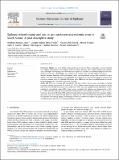Epilepsy-related Stigma and Cost in Two Onchocerciasis-endemic Areas in South Sudan: A Pilot Descriptive Study
View/
Publication Date
2020-08-06Type
Article, Journalviews
downloads
Metadata
Show full item recordCitation
Jada SR, Siewe Fodjo JN, Abd-Elfarag G, Tionga M, Carter JY, Logora MY, Newton C, Colebunders R. Epilepsy-related stigma and cost in two onchocerciasis-endemic areas in South Sudan: A pilot descriptive study. Seizure. 2020 Oct;81:151-156. doi: 10.1016/j.seizure.2020.08.003. Epub 2020 Aug 11. PMID: 32810838.
Abstract/
Introduction: Epilepsy is a major public health concern in sub-Saharan Africa, particularly in resource-limited rural villages where persons with epilepsy (PWE) are often confronted with a wide treatment gap, frequent stigma and high cost of epilepsy care. We investigated stigma and economic cost related to epilepsy in the states of Maridi and Amadi in South Sudan, two onchocerciasis endemic areas with high epilepsy prevalence. Methods: Between November 2019 and February 2020, community-based surveys were conducted in eight villages of Maridi and Amadi States. Consenting PWE were identified via a door-to-door approach, and perceived stigma was assessed using the validated Kilifi stigma scale. Additional data about household income, as well as epilepsy-related direct and indirect costs were collected. Results: 239 PWE were recruited (95 from Maridi, 144 from Amadi). Stigma scores were higher in Maridi compared to Amadi (mean scores: 13.9 vs 6.5, p < 0.001). Mean weighted epilepsy costs per month in Maridi (38.4 USD) were double those observed in Amadi (17.6 USD). The main epilepsy-related expenditure was the purchase of anti-epileptic drugs (AED). Stigma scores correlated with epilepsy cost (Spearman-rho = 0.24, p < 0.001) and were positively associated with traditional medicine use (regression estimate = 1.9; p = 0.027). Conclusion: In rural South Sudan, PWE and their families often experienced stigma from the community. Higher perceived stigma was associated with traditional medicine use, which increased the overall cost of epilepsy management. Demystifying epilepsy and making AED more accessible would improve the quality of life of PWE and their families, and reduce the economic burden of epilepsy.
Further Details
1059-1311/ Crown Copyright © 2020 Published by Elsevier Ltd on behalf of British Epilepsy Association. This is an open access article under the CC BY-NC-ND license (http://creativecommons.org/licenses/by-nc-nd/4.0/).
Publisher
ElsevierCollections
- General - GEN [367]

